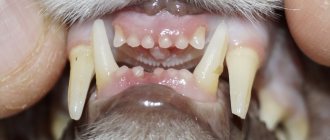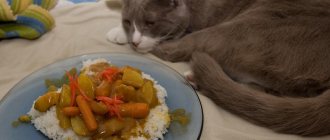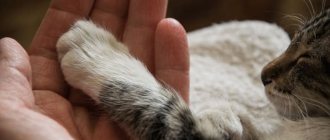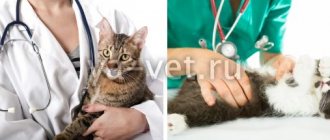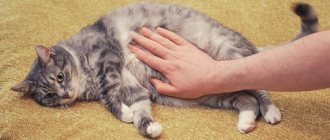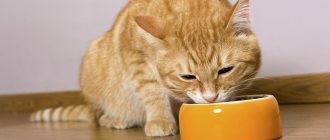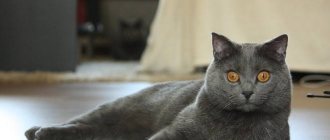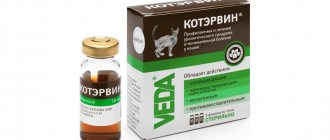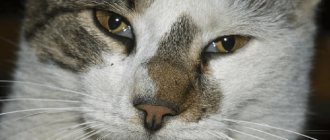Milk and permanent teeth of cats
Kittens are born completely helpless - not only blind, but also toothless. At first, they don’t need teeth, given the dairy diet. The first incisors appear at 2–4 weeks of age, canines erupt at 3–4 weeks, and premolars at 3–8 weeks. This does not cause any particular problems for kittens. They just want to chew on something all the time, which, in the absence of specially designated toys, can cause problems for their owners. By the end of the third month of life, the kitten is already equipped with a full set of 26 milk teeth, which he successfully uses where necessary, and especially actively where it is not needed.
The kitten tries to taste everything
Table: 26 baby teeth in kittens
| Incisors | 6 | Fangs | 2 | Premolars | 6 | Molars | No |
| Incisors | 6 | Fangs | 2 | Premolars | 4 | Molars | No |
Later, at about 3–5 months, the turn of permanent teeth comes. First, at 3–5 months, the incisors are replaced, then at 4–5 months, fangs erupt, and at 4–6 months, premolars, and last of all, molars grow - “wisdom” teeth, which small kittens do not have. Normally, the process of changing teeth ends by 7 months, and the kitten stops gnawing everything it sees and can reach, to the delight of its owners.
Table: 30 permanent teeth in cats
| Incisors | 6 | Fangs | 2 | Premolars | 6 | Molars | 2 |
| Incisors | 6 | Fangs | 2 | Premolars | 4 | Molars | 2 |
A cat has 30 permanent teeth
The structure of a cat's teeth is approximately the same as that of a human:
- The pulp is the inner part where the nerve cells and blood vessels are located.
- Dentine is the covering of the pulp.
- Enamel is a hard bone formation devoid of nerve endings.
Teeth play a larger role in the life of cats than in humans. If we mainly chew and grind food with our teeth, then a cat’s teeth are its deadly weapon. It is with sharp fangs that she kills prey, plunging them into its spine, and then tears the carcass into pieces. In principle, a cat is capable of digesting food anyway, swallowing large pieces. Therefore, if for some reason a pet is left without teeth and caring owners feed it liquid, ground food, it will be able to live a long and happy life.
Teeth are a cat's deadly weapon.
Is it scary that a cat has no teeth?
A cat's lack of teeth is a negative phenomenon that can make serious adjustments to his life. He can no longer hunt and defend himself from the attacks of his younger and stronger relatives, and can only eat soft food.
It is advisable to keep an elderly cat that has lost teeth at home, and, if possible, not let it go outside. You never know who he will decide to fight with, or, on the contrary, who will attack him. The consequences in both cases can be disastrous.
You'll have to reconsider your pet's diet. The cat is a carnivore, which means it needs meat. But he can no longer chew its fibers on his own. The solution can be found by giving it to the cat in a rolled and ground form.
Teeth instead of a passport, or how to find out the age of a cat
It is by the teeth that you can determine the age of a pet. Their number and condition will tell a specialist a lot. Here are the age-related changes that occur to cat teeth:
- 2–4 weeks—baby teeth erupt;
- 3–4 months – the process of changing baby teeth begins;
- 5–7 months – the replacement of baby teeth with permanent ones ends;
- 1 year - healthy cats have snow-white teeth, without signs of tartar;
- 2 years - the middle incisors on the lower jaw are gradually worn away, the enamel turns yellow, and tartar forms;
- 3–5 years - the process of abrasion of the central incisors on the upper jaw, the outermost ones on the lower jaw and canines begins;
- 6–7 years - the pigmentation of tooth enamel is disrupted, the outer incisors of the upper jaw begin to wear off;
- from the age of 10, tooth loss begins - first the central incisors, then the middle and outer incisors;
- By the age of 15–18 years, a cat loses its fangs.
But don’t worry, the time at which these processes begin depends very much on the health and lifestyle of the particular cat, and the main role is played by the quality of care from the owners.
Teeth tell everything about a cat's age instead of a passport.
What not to do
If there is a suspicion of a broken jaw in a cat, the animal should be given a powerful painkiller, and then taken to a veterinarian or called to the house. The doctor will examine the purr, determine the severity of his condition and prescribe an examination.
The cat will have an X-ray, MRI, and blood tests. Treatment depends on the type of fracture. If it is simple, a tight bandage is applied to the animal’s muzzle or a special muzzle is put on. The jaw is fixed with external plates, which are secured with medical pins. After healing, the plates are removed. In case of severe fractures, they are also installed, but remain with the animal for life. Such procedures are done if a cat’s lower jaw is broken.
In case of a fragmentation injury of the upper jaw, the palatine bones are rigidly fixed, screwed to each other with special devices. If teeth were damaged during a fracture, they are secured with plates. In case of multiple small fragments, the damaged jaw is removed.
If your cat has a broken jaw, you should not try to immediately apply a bandage yourself! Without an accurate diagnosis and establishment of the type of injury, the animal can be harmed. All operations must be carried out professionally, otherwise there is a high risk of suppuration and all kinds of complications. The pet must be given sedatives and shown to a doctor as soon as possible.
Dental problems and methods for solving them
Unfortunately, cats, like people, are familiar with the dentist. Despite their seemingly healthy lifestyle in comfortable conditions, or perhaps because of it, they are tormented by caries. Over time, teeth lose their whiteness, become covered with plaque, and tartar forms, leading to their loss. Sometimes the fault lies with the owners themselves. By feeding our beloved pet soft pastes and limiting solid food, we deprive him of his usual tools for cleaning plaque. In nature, when hunting and gnawing on prey, cats automatically brush their teeth and maintain the balance of microflora in their mouth.
Solid foods, such as dry food, can help prevent tartar buildup in cats.
But it is not necessary to take your cat out hunting if problems are detected. We can help our furry friends ourselves. It is necessary to constantly examine the animal’s mouth, and at the first sign of any violations, contact a specialist.
A proper diet or special hard treats will prevent the formation of tartar. And of course, brushing teeth should be mandatory for your pet. In this case, not our human toothpastes are used, but special ones - with a trust-inspiring smell and taste (fish, chicken or something else that tailed animals might like). A cat, like a person, must be accustomed to this procedure from childhood, then it will become, although not the most pleasant, familiar.
Brushing your cat's teeth will prevent tartar from forming.
If you are unable to brush your pet’s teeth at home, then you will have to go to the veterinary clinic. There, dental plaque is removed using ultrasound using a special device - an ultrasonic scaler. The amplitude and frequency of vibrations are selected on it, allowing you to easily remove tartar from the surface of the tooth without damaging the enamel. Although this is painless for pets, it is still quite unpleasant. And if a loving owner could not convince the cat to brush its teeth, then the doctor, valuing his life, will not even try to carry out such procedures without anesthesia. The price of a snow-white smile will be severe stress for your pet, not to mention a bill from the clinic.
Video: brushing your cat’s teeth and other tartar prevention measures
Prevention of dental pathologies
To prevent your four-legged pet from having problems with teeth, you must follow the following rules:
- regularly remove plaque and tartar;
- feed your pet high-quality ready-made food or natural food made from quality products;
- when feeding the animal with natural food, periodically give it vitamins previously agreed upon with the veterinarian;
- Take the cat to the veterinarian for a preventive examination at least once a year;
- promptly treat any diseases identified in the cat;
- Do not feed your four-legged pet too soft food.
Many owners do not neglect even such a procedure as oral hygiene. In particular, you need to clean even newly erupted teeth using a special brush and unscented cleaning powder. However, keep in mind: cats are extremely averse to such procedures.
The True History of Brushing Cat Teeth
The author of these lines, while writing the article, also decided to look into the mouth of his cat, and this is what came out of it.
To begin with, the peacefully sleeping cat was awakened by demands to show his teeth.
I don't know about other pets, but ours will never do what we want. And now, apparently out of spite, he tightly closed his jaws no worse than a real bulldog and flatly refused to satisfy our curiosity. I had to resort to a “master key” in the form of a piece of sausage. While Barsik quickly chewed it, suffering from obsessive attention to his person, we tried to count his teeth. The sausage ran out before it was possible to do this.
So, the age of the cat could not be determined. But, looking into his mouth, I managed to notice that his fangs were not at all as white as I would like, and were covered with a yellow coating. The smell also left much to be desired. Considering that, in principle, the cat leads a healthy lifestyle and has no bad habits, this was strange. However, no one had ever brushed his teeth, but apparently they should have.
Often, in order to brush a cat’s teeth, you have to “persuad” him for a long time to open his mouth.
My daughter was perplexed as to why she needed to brush her cat’s teeth. I explained that yellow plaque can lead to tartar, which can lead to caries and even tooth loss. In addition, brushing your cat's teeth would eliminate the unpleasant odor from the cat's mouth.
One method of cleaning cat teeth found on the Internet was to rub the animal's teeth with red wine and soda.
Such a proposal was met with indignation by both the cat and the husband, from whom the thought of transferring a valuable product caused protest. I clarified that the wine needed was cheap, like vinegar. The husband unexpectedly objected that it was forbidden to rinse the cat’s mouth with anything (he managed to realize that it was unlikely that a whole bottle would be used for one cat, and therefore it could then be used for its intended purpose). This means that the wine must be worthy.
Barsik resolutely made it clear that he would not allow such dubious experiments to be carried out on himself. However, the husband no longer insisted on his participation in drinking good wine.
Another option for cleaning teeth was dry hard treats, the consumption of which gives the pet pleasure and removes plaque.
Alas, this method did not work for the cat either. No matter how we tempted him with chopsticks, no matter how we rolled our eyes, inhaling their wonderful aroma, no matter how we smacked our lips in delight, the cat did not buy it. He studied the so-called delicacy carefully, and then stared at us with contempt.
On the shelves of pet stores you can find special treats that (according to manufacturers) will not only please your pet, but will also help his teeth stay healthy
So, the relatively peaceful method of brushing the cat’s teeth did not work, and we had to take action.
It was decided to brush your teeth traditionally with a brush and toothpaste. They didn’t even offer our pasta to the cat, but bought a special one with the aroma of fish. Experts advise carrying out the procedure at the quietest time, when the pet has eaten and is not going to sleep. Here we encountered the first problem. The fact is that our cat either eats or sleeps. In between, he sits by the refrigerator and loudly hints that the couple should eat. Suggesting that he brush his teeth at this moment seemed extremely unreasonable.
The second problem was the lack of people willing to get into the cat’s mouth and generally participate in this process in any way, other than giving me stupid advice. Everyone still remembered well how they once stuffed Barsik into a carrier, taking him to the dacha, how he resisted and what damage he caused to those around him. I hoped that my husband would at least hold it, and I read the instructions to him. According to it, the cat needs to be placed between the legs, with the tail towards you, because the cat, apparently not enjoying the process, will begin to back away. My husband vividly imagined this, shuddered and asked with offense why some stupid cat was more valuable to me than the life and health of my husband.
This means that the cat will have to be swaddled, as some advise. I resolutely went in search of the cat with a blanket and a support group staying at some distance. The cat was found staring drowsily into the bowl and indulging in thoughts: whether to eat more, or to sleep already. When he saw us, he became alert and covered his ears. Then he quickly, forgetting about dignity, slipped under the sofa.
I sat down next to him and gave a heartfelt speech about the dangers of tartar and the need to brush your teeth. I scared the cat by going to the dentist and promised unlimited visits to the refrigerator if he agreed. The cat remained stubbornly silent and did not come out.
They managed to catch the cat only after a couple of hours. And the operation began:
- They threw a blanket over Barsik and wrapped him tightly in a ball. The cat fought like a lion and screamed loudly.
- They freed the cat's head. The resisting lump was unwound on one side - a large red butt appeared before our eyes, it was shoved back, and a grinning muzzle was revealed on the other side.
- Experts advised taking a brush like one for small children, that is, made of soft silicone that fits on your finger. It’s a pity that they didn’t warn that the cats’ teeth would pierce this structure instantly, as I was convinced of by frivolously sticking my finger into the screaming mouth. Here my screams were added to the cat’s screams.
- I quickly grabbed the first toothbrush I came across, as it later turned out very inopportunely, it was my husband’s. There was no time to smear it with paste; the patient dangerously turned out of the trap. The cat furiously attacked the brush, trying to bite it. Apparently, this is the meaning of brushing your teeth, it flashed through my head.
- Having taken revenge on the instrument for all the insults, Barsik finally freed his paws with outstretched claws, after which the desire to hold it instantly disappeared. Having hit everyone with its paws a couple of times, the cat proudly but hastily left the battlefield. He crawled under the closet and was loudly indignant at what had happened.
Repeating the procedure is not in the plans of either me, the support group, or the cat. However, the thought of using the services of a specialist in a veterinary clinic scares us no less...
Osteomyelitis of the jaw
A very serious disease in cats is osteomyelitis of the jaw. It occurs against the background of a chronic source of infection, for example, advanced periodontal disease or gingivitis. The process is started by pathogenic microflora that has invaded the bone marrow. The destructive process involves the bone and periosteum. Gradually, hard tissues are destroyed and a purulent cavity is formed. The destruction of jaw bone tissue spreads, complicated by osteitis and periostitis.
In old animals, pathogens can enter the bone marrow through the bloodstream from a source of infection located in other organs. Pathogenic microflora can penetrate through an injured bone or odontogenically from a tooth. Statistics show that often the cause of jaw osteomyelitis in cats is canine trauma, especially impacted tooth dislocation. Since the fangs protrude beyond the boundaries of the dentition, they are the ones that are primarily affected by falls and impacts.
The disease threatens not only tooth loss, but also blood poisoning. Dental diseases in cats affect the function of the digestive system. If the integrity of the dentition or pathology of the tooth crown is damaged, the cat does not grind food well and swallows large pieces, which leads to impaired digestion and absorption, and, as a result, various gastrointestinal diseases.
Types of fractures
All jaw injuries can be divided into two large groups: favorable and unfavorable. Differentiation is related to the severity of the damage, the presence/absence of bone fragments, the condition of the pet, etc. Let's look at these types in a little more detail.
Favorable
In the case where the jaw remains in a relatively normal position, does not hang or twist to one side, the fracture can be considered “favorable”. This is often considered to be damage to the upper jaw (don’t forget that they are still extremely dangerous). Perhaps even the simplest treatment at home will help. Of course, if the cat’s owner has at least basic veterinary skills and knows how to apply tight bandages and plaster.
Adverse
If the fracture caused displacement of the jaw, it can be considered unfavorable. In particular, with such injuries, the masticatory muscles are often torn. If the damage additionally passes through the symphysis, the pet’s mouth droops downwards and hangs on bundles of ligaments and blood vessels. It looks very scary, the pathology is extremely dangerous for the health and life of the pet.

